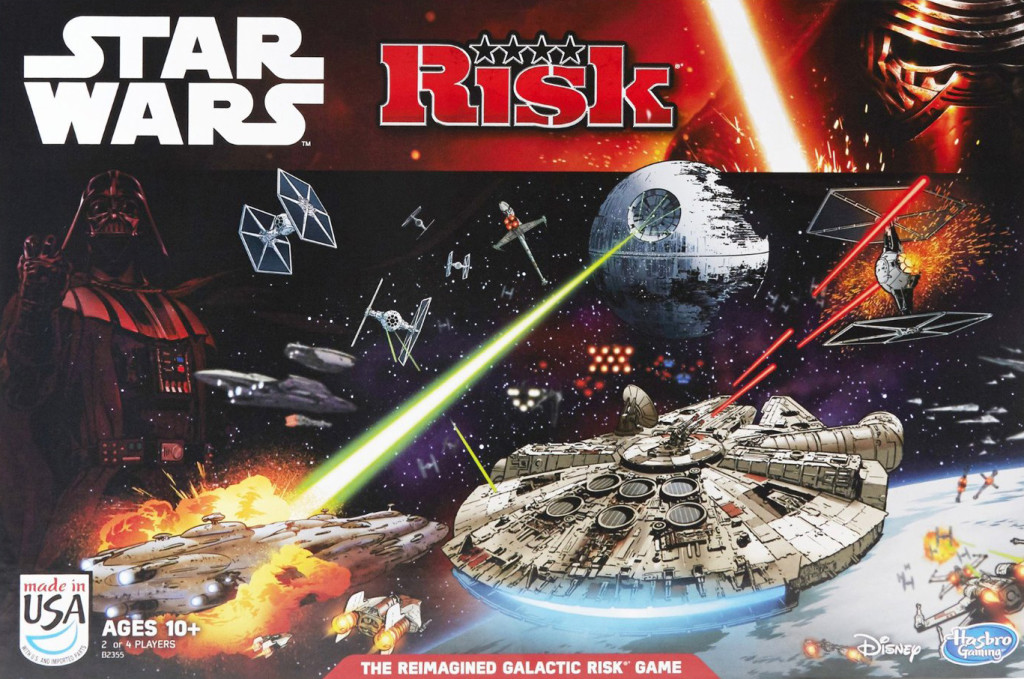A long time ago in a living room about twenty miles from where I currently am, I watched the most epic three-fold battle sequence I’ve ever seen: The Battle of Endor via “Star Wars Episode VI: Return of the Jedi”. No seriously, it was epic enough to where I’d skip the rest of the movie and only watch that part…I was a kid, what do you want? With the recent influx of Star Wars toys hitting the shelves for the upcoming Star Wars movie in December, I figured I’d do my part and give this newcomer a go. Was the Force strong with this one, or did it turn out to be a big heaping pile of bantha poodoo?
Components
The game includes 3 game board pieces, 20 X-wing fighters, 16 Y-wing fighters, 15 B-wing fighters, 56 TIE fighters, 6 Rebel fleet markers, 1 Millennium Falcon token, 1 Executor token, 4 hit tokens, 9 Stormtrooper tokens, 1 Rebel Strike Team token, 30 Empire order cards, 30 Rebel order cards, 5 dice, and instructions.
Setup & Gameplay
First, players decide who will play as the Empire and who will play as the Rebels. The ships are set up in a particular way (there’s a picture in the manual specifying where the fighters and cardboard fleet markers go) and each player receives their respective deck of cards. Said cards are shuffled and each receives six to form their starting hand. The hit and Rebel Strike Team tokens are placed in their appropriate/respective positions.
The Rebel player’s objective is to take out the shield generator by advancing the Rebel Strike Force token to the end of the track, then taking out the Death Star. The Imperial player’s objective is to defeat all Rebel ships before this happens. Winning the Luke/Vader battle isn’t necessary, but gives the winner a bonus during the game.
The game is played over a series of rounds. To begin a round, each player lays down three cards to form an order pile (the ordering is important). The other three cards are put aside. Starting with the Rebels, each player flips over the top card and chooses one order to resolve. Some situations allow for extra cards to be added to the bottom of the order pile. Once orders are resolved, players draw three cards and the process repeats until one player wins the game.
Editor’s Note: The above doesn’t cover all of the rules found in the manual (the individual orders, for example), but should give you an idea as to how the game is played.
The Review
Firstly, let’s get the complaints out of the way. This game has zero resemblance to “Risk” and I don’t know why they bothered slapping that word into the title. This is not the “Risk” I grew up with. The smaller snubfighters are plastic and have stands, yet the capital ships and Millennium Falcon are flat pieces of cardboard. The X-Wings have the same attack power as TIE Fighters, which is something I can nerd out about because I’ve played PC games like “X-Wing” and “TIE Fighter” growing up and know their capabilities in and out. X-Wings should be stronger, plain and simple (they have shields, TIE Fighters do not, etc.). I do appreciate that the board resembles a TIE Advanced X1, however the cockpit is WAY too big. Lastly, the rulebook isn’t as thorough as it could be, considering the rather lengthy “rules clarification” threads I’m seeing on BoardGameGeek.
Once you get past the little details (that one would only notice if they’re a hardcore fan) and remember that this is, at its heart, an “Ameri-trash” game, you’ll begin to chalk up the inconsistencies to game designers not being as hardcore a fan as you. Heck, you may even begin to accept it. Also, I’m sure they were on a limited budget. After all, we can’t expect Fantasy Flight X-Wing Miniatures quality here, seeing as how the game retails for around thirty bucks. The gameplay is really where it’s at and while the Rebels and Imperials not 100% balanced in my opinion (the Rebels seem to win more often), it is good and quick fun.
The game does a pretty good job in capturing the suspense behind The Battle of Endor. The cards players get on a regular basis have multiple actions on them, though only one of said actions can be used. This leads to some pretty hard choices as there seems to be never enough time to completely dominate all three of the different parts of the board: 1) Luke vs Vader, 2) Death Star Space Battle, and the 3) Ground Assault on Endor. The Rebels are tasked with taking out the shield generator on the surface and then destroying the Death Star while the Imperials are tasked with holding out long enough to wipe out the Rebel forces. No matter which side you choose, you’re in for a rough and suspenseful ride.
Do I recommend “Risk: Star Wars Edition”? In short, yes. If you’re a Star Wars or Eurogame fan, my advice is to turn your nitpicking tendencies off and just enjoy it for the imperfect Star Wars themed game it is. It could use some rebalancing (that X-Wing bit is REALLY bothering me), but it’s fairly enjoyable as-is.
Final Verdict: 7/10
—



I think one way that you can ease your mind about the x-wing = tiefighter thing is to think about it like a tiefighter token represent more than a single tiefighter – maybe even a 3 tiefighter group or something. after all, in the battle of endor, the rebel ships are basically swimming through tie fighters and just visually, the rebels were vastly outnumbered. so it’s a bit of abstraction so that they didn’t have to fill the box up with nothing but tiefighter pieces.
good write up.